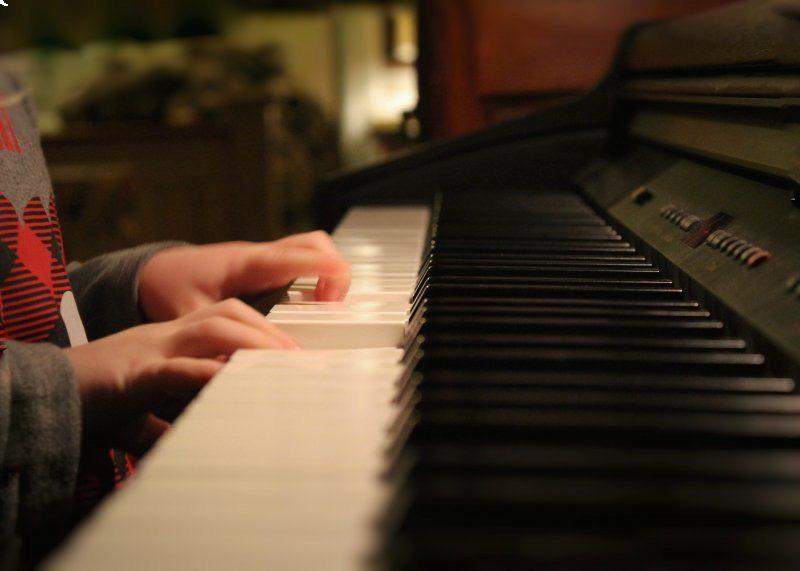Are you considering a new piano for your home? Not sure about the pros and cons of different types of pianos?
If you or your child are interested in learning to play the piano, it’s natural to be concerned about upfront costs. Pianos can be expensive! A decent upright piano from a retail store can cost well over $2000. And that’s at the low end. Then, there’s the task of keeping it tuned, moving costs, and finding a large enough place in your home.
These obstacles can be discouraging. Fortunately, there are cost and space-effective options available for beginners. There is no need for a heavy investment, especially if you’re still deciding whether you or your child will play piano in the long term.
Grand and Upright Pianos
Have you spent time looking at different types of pianos, and decided you absolutely want an authentic, acoustic piano? If so, there are two main types to consider. The first is the “grand” piano. The second is the “upright” piano.
Type #1: Grand Pianos
Grand pianos are the larger style of acoustic piano. Standard grand pianos measure about 5-6 feet in length and width. These are also the most expensive option. Grand pianos start around $3000 for a used instrument. And it costs between $250-$650 to hire local movers.
Type #2: Upright Pianos
The upright piano takes up far less space, and is only about 2.5ft in length. Upright pianos are also significantly less expensive. To buy a used upright at a retail store starts around $2000. You can also find private sellers on Facebook Marketplace or Craigslist that are willing to part with pianos for well under $1000. Some people might even offer a piano for just a few hundred if you can cover the moving costs. Standard moving costs are usually around $200.
Both Types of Piano Has its Pros & Cons
Each acoustic piano has its own quirks and differences in the sound quality, depending on the style and brand. But to most, the differences are slight and ultimately inconsequential to beginners.
Maintenance on Acoustic Pianos
Let’s look at some factors to consider if you choose an acoustic piano. First, it’s important to consider the cost of maintaining your instrument. Tuning your piano is important, and must be performed by a professional. Tuning and maintaining your piano can cost around $150. Specific tuning costs depend on your piano’s condition, and how long it has been since its last tuning. If it’s the first time your piano has been tuned, or it has been more than two years, piano tuners may charge an additional fee. Usually around $50.
Electric Pianos
Electric pianos are usually the most affordable option. Decent options come in at around $500. The quality of the speakers and additional features will vary depending on price point. The least expensive full-sized keyboards are priced around $300. Less expensive models may not be full-sized, and they may lack features like weighted keys.
There are a variety of features that different brands will include. Most will have the ability to alter the quality of the sound to mimic a traditional acoustic piano, electric jazz piano, or synthesizer boards. They may also include features like a metronomes and prerecorded tracks. There are two features in particular that are the most important to consider when shopping for an electric piano.
Feature #1: Weighted Keys
Weighted keys make the keyboard feel more natural. And they give you the ability to control the volume and articulation of your music. Without weighted keys, the piano will be limited to an “on or off” sound. Consequently, important aspects of musical expression will be lost.
Feature #2: Foot Pedals
Your electric piano should have built-in or plug-in sustain and sostenuto foot pedals. The sustain pedal allows you to let piano sounds persist even after you lift your fingers off the keys. The sostenuto pedal allows for a similar but more targeted effect. Both are useful musical tools that become more important as you become more advanced.
Personal Recommendations
If you or your child are just starting out on the piano, consider a full-sized electric keyboard. It’s best to choose a keyboard with weighted keys and foot pedal options.
Early lessons tend to focus on building finger dexterity and music reading. Both of these can be accomplished on the most basic of keyboards. As the student improves, they will not be stifled by the limited features of a smaller, less capable keyboard model.
As an added benefit, the electric keyboard will have a volume dial, so practice time will not be too disruptive for the rest of the household.
In conclusion, remember that different types of piano are right for different situations. You may love the idea of an acoustic piano, or feel inspired playing an electric piano. Take some time to try out different pianos before making a decision.
Lance Russell



